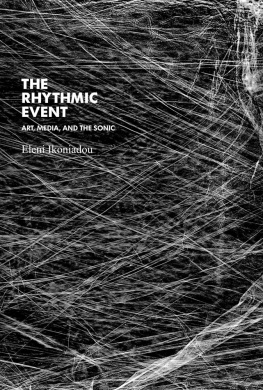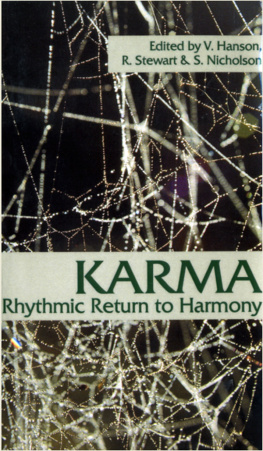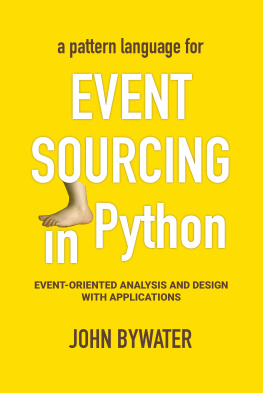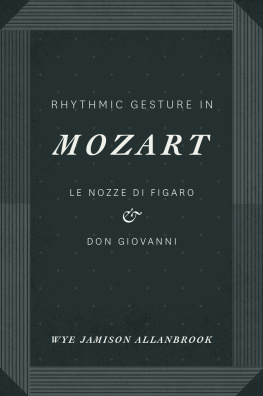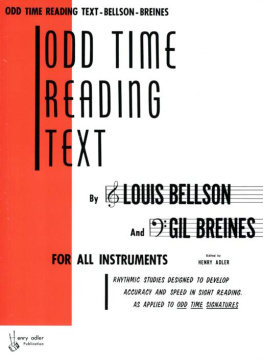Ikoniadou - The Rhythmic Event
Here you can read online Ikoniadou - The Rhythmic Event full text of the book (entire story) in english for free. Download pdf and epub, get meaning, cover and reviews about this ebook. year: 2014, publisher: MIT Press, genre: Romance novel. Description of the work, (preface) as well as reviews are available. Best literature library LitArk.com created for fans of good reading and offers a wide selection of genres:
Romance novel
Science fiction
Adventure
Detective
Science
History
Home and family
Prose
Art
Politics
Computer
Non-fiction
Religion
Business
Children
Humor
Choose a favorite category and find really read worthwhile books. Enjoy immersion in the world of imagination, feel the emotions of the characters or learn something new for yourself, make an fascinating discovery.
- Book:The Rhythmic Event
- Author:
- Publisher:MIT Press
- Genre:
- Year:2014
- Rating:3 / 5
- Favourites:Add to favourites
- Your mark:
- 60
- 1
- 2
- 3
- 4
- 5
The Rhythmic Event: summary, description and annotation
We offer to read an annotation, description, summary or preface (depends on what the author of the book "The Rhythmic Event" wrote himself). If you haven't found the necessary information about the book — write in the comments, we will try to find it.
The Rhythmic Event — read online for free the complete book (whole text) full work
Below is the text of the book, divided by pages. System saving the place of the last page read, allows you to conveniently read the book "The Rhythmic Event" online for free, without having to search again every time where you left off. Put a bookmark, and you can go to the page where you finished reading at any time.
Font size:
Interval:
Bookmark:
The Rhythmic Event
Technologies of Lived Abstraction
Brian Massumi and Erin Manning, editors
Relationscapes: Movement, Art, Philosophy,
Erin Manning, 2009
Without Criteria: Kant, Whitehead, Deleuze, and Aesthetics,
Steven Shaviro, 2009
Sonic Warfare: Sound, Affect, and the Ecology of Fear,
Steve Goodman, 2009
Semblance and Event: Activist Philosophy and the Occurrent Arts,
Brian Massumi, 2011
Gilbert Simondon and the Philosophy of the Transindividual,
Muriel Combes, translated by Thomas LaMarre, 2012
Contagious Architecture: For an Aesthetic Computation of Space,
Luciana Parisi, 2013
Moving without a Body: Digital Philosophy and Choreographic Thoughts,
Stamatia Portanova, 2013
An Aesthesia of Networks: Conjunctive Experience in Art and Technology,
Anna Munster, 2013
The Rhythmic Event: Art, Media, and the Sonic,
Eleni Ikoniadou, 2014
The Rhythmic Event
Art, Media, and the Sonic
Eleni Ikoniadou
The MIT Press
Cambridge, Massachusetts
London, England
2014 Massachusetts Institute of Technology
All rights reserved. No part of this book may be reproduced in any form by any electronic or mechanical means (including photocopying, recording, or information storage and retrieval) without permission in writing from the publisher.
Library of Congress Cataloging-in-Publication Data is available.
Ikoniadou, Eleni.
The rhythmic event : art, media, and the sonic / Eleni Ikoniadou.
pages cm.(Technologies of lived abstraction)
Includes bibliographical references and index.
ISBN 978-0-262-02764-9(hardcover : alk. paper)
ISBN 978-0-262-32095-5 (retail e-book)
1. Electronic musicHistory and criticism. 2. Avant-garde (Music). I. Title.
ML1380.I52 2014
786.711dc23
2013048590
After all, there is nothing real outside our perception of reality, is there?
Brian OBlivion
Series Foreword
What moves as a body, returns as the movement of thought.
Of subjectivity (in its nascent state)
Of the social (in its mutant state)
Of the environment (at the point it can be reinvented)
A process set up anywhere reverberates everywhere.
The Technologies of Lived Abstraction book series is dedicated to work of transdisciplinary reach inquiring critically but especially creatively into processes of subjective, social, and ethical-political emergence abroad in the world today. Thought and body, abstract and concrete, local and global, individual and collective: the works presented are not content to rest with the habitual divisions. They explore how these facets come formatively, reverberatively together, if only to form the movement by which they come again to differ.
Possible paradigms are many: autonomization, relation; emergence, complexity, process; individuation, (auto)poiesis; direct perception, embodied perception, perception-as-action; speculative pragmatism, speculative realism, radical empiricism; mediation, virtualization; ecology of practices, media ecology; technicity; micropolitics, biopolitics, ontopower. Yet there will be a common aim: to catch new thought and action dawning, at a creative crossing. The Technologies of Lived Abstraction series orients to the creativity at this crossing, in virtue of which life everywhere can be considered germinally aesthetic, and the aesthetic anywhere already political.
Concepts must be experienced. They are lived.
Erin Manning and Brian Massumi
Acknowledgments
This book facilitates concepts that germinated during my research project and thus benefits from the thoughtful guidance, inspiration, and support of Steve Goodman, Luciana Parisi, Adrian Mackenzie, and Jussi Parikka.
Earlier versions of parts of the introduction and chapters 2 and 3 were published in the journals Culture Machine (vol. 11, 2010), Senses and Society (vol. 3, no. 7, November 2012), and Body and Society (forthcoming). Thank you to the editors of the journals and reviewers of the articles.
I wish to thank my colleagues at the London Graduate School, Kingston University, for their assistance in organizing the Rhythm & Event conference (October 2011), which became another hub for experimenting with some of the core ideas in the book. Many of the theorists, colleagues, and friends present at this event have enormously stimulated my research and I am grateful for our discussions.
My gratitude also goes to the artists, Anne Niemetz and Andrew Pelling, Gisle Trudel and Stphane Claude, Nick Knouf, Marie Sester, Lynn Pook and Julien Clauss, and Idris Khan, whose projects became the vehicles for finding rhythm in the event and who generously provided comments on my ideas as well as permission to use their images.
My thanks also to Doug Sery, Katie Helke, Susan Buckley, and Judy Feldmann at MIT Press for their valuable help, and to the two anonymous reviewers for their close engagement and useful observations.
I am grateful to the collective intelligence of Erin Manning and Brian Massumi for their belief in transdisciplinary speculative thought and for their influence on my work, which goes far beyond this text.
My special thanks go to Vasilis Marmatakis for the astonishing cover and for his skill in transmuting abstract concepts into beautiful design. Also to my sister Mary Ikoniadou and my parents Eleonora and Theodoros, whose love and constant practical support are indispensable in my life.
Special lovefor their friendship, enthusiasm, and encouragementto Annie Pender, Carolina Vallejo (and Mana and Shin), Olga Goriunova, Orsalia Dimitriou, Konstantinos Tsimonis, Stathis Sideris, and to all my friends in London and abroad. Thank you also to Tasia Voutyropoulou and Elias Cosindas.
Above all,
to Yannis Zachos, whose loving presence, great sense of humor, and confidence in me have been vital to the completion of this project and are behind everything I do;
and to our daughter Lexi, who coauthored the book from the womb and who will always be the event of all events.
We are on the same plateau. This book is dedicated to you.
Introduction: Abstract Audio
Rhythm is the interface between humans and machines, between distributed minds and overlapping mediascapes. Digital rhythm incites mutation across the networks.
Kodwo Eshun
In a small lighthouse in Londons Docklands, overlooking the unimpressive Millennium Dome, sits a one-thousand-year-long digital sound artwork called Longplayer, by ex-Pogues member Jem Finer. The raw material for the piece consists in twenty minutes of inharmonic Tibetan singing bowls, time-stretched by Supercollider software on an iMac to create an extremely lengthy, barely audible loop that will play without repetition for a thousand years. Longplayer began its extensive life on January 1, 2000, marking the beginning of the new millennium, and will continue to play until 2999. It seems that the twenty-first century began with an unusual abstract audio eventunusual because it is part of an unexpected turn toward the sonic, in the case of Longplayer, as the chosen medium with which to announce the arrival of the digital at the dawn of the new century.
Part musical score, part art installation, Longplayer is created from instant to instant by a simple system operating upon a piece of musical raw material (Finer, quoted in Carlyle 2007, 42). Its long durational score provides an alternative computational paradigm for digital sound design. Its compositional value rests on an endless nonlinear iteration of sonic matter that will only loop after a thousand years have passed, at which point it will complete its cycle and begin again. In so doing, the project marks a passage from the mere technological organization of music as the finite accumulation of bits to the uncertainty and openness of cosmic sound. The antiteleology of the system means that it will keep on playing endlessly, continuously reconfiguring new rhythmic planes out of the digital landscape that it inhabits. According to Kodwo Eshun,
Next pageFont size:
Interval:
Bookmark:
Similar books «The Rhythmic Event»
Look at similar books to The Rhythmic Event. We have selected literature similar in name and meaning in the hope of providing readers with more options to find new, interesting, not yet read works.
Discussion, reviews of the book The Rhythmic Event and just readers' own opinions. Leave your comments, write what you think about the work, its meaning or the main characters. Specify what exactly you liked and what you didn't like, and why you think so.

